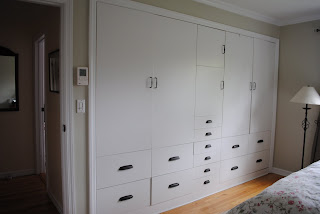
(PHOTO: Wall of Closet)
My husband and I are practical people, often to a fault. Most decisions big or small require intense scrutiny and analysis. I recently stood in a shoe store for over 30 minutes deciding between two pairs of shoes that were similar but one had a heel and one was flat. The prices were significantly reduced and since I rarely buy anything for myself, I could have eked out the double buy, but that would not have been my way. Anyway, maybe you see where I am going with this. We are still in a holding pattern re: our house project, which gives us plentiful time for further analysis. And so, upon further analysis, we have decided to scale back the project once again.
We recently discovered a very interesting, post-McMansion series of books by Sarah Susanka, called The Not So Big House Books. An architect by trade, Ms. Susanka is peddling the idea that much of what we truly need and desire can be found within the existing walls of our homes, and that by building big we will not necessarily build better. Her timing could not be better – as Americans begin to reject the size and scale of homes built over the past 20 or so years and are looking for more economical solutions to their requirements for modern living, building big is causing big problems. In renovating our Raised Ranch, we have always felt that our house basically suits our needs, but we want “a little more”. We have also tended to back away from plans that were too big (the Colonial idea) or too wasteful and redundant (the first plan we scrapped).
As noted in an earlier post, we have heard talk of homeowners eliminating formal living rooms and/or dining rooms in their renovation plans in favor of more open, less conventional floor plans. It occurred to us that while we like the idea of a formal dining room, in our current setup the dining room table serves as a repository for all of the junk we accumulate, be it mail, old homework, notices, and anything else that does not fit on the refrigerator (another repository!). Unfortunately, given the casual nature of our home, we have little use for this table except when entertaining. Our goal in renovating and adding on is to create spaces that will fill our needs. We need room for a piano; we need comfortable seating areas; we need a place to sit and have a meal with friends. But do we really need a formal dining room? At this point, the arrow is pointing to “no”.
Here is how we have changed our plan, to reduce costs and create some efficiencies. We will add a large room to the back of the house – somewhere in the neighborhood of 15’ x 25’. The room will be a family room with a formal dining table and hutch at one end. When I say formal, please take it with a grain of salt. There will be no Queen Anne highboy or anything like that. At most, we will invest in a modest set from Ethan Allen with simple lines, possibly in the Mission style. It will be a large room that flows into the kitchen, perfect for family living and entertaining. Instead of a table in the kitchen, we will use that space for a powder room, and create a breakfast bar for casual family meals. The living room will stay the same, and the hall bath will belong to the children. The only other change will be removal of the California-style closets in our bedroom to create a pocket for the bed with recessed reading lights above. This will add two feet to the Master Bedroom, making it 13 ½’ x 13’ – not huge, but certainly respectable. Of course, a few window changes and an added door to the deck from the MBR will bring in more light and hopefully create a sense of greater space as well.
As we tweak this plan, we feel increasingly confident that it will satisfy our family’s needs while staying within a manageable budget. We have seen and heard of many examples where people simply over-improved or over-built their homes, and since we plan to stay here for a long time, it is imperative that we get it right the first time. Building too big will have economic consequences (taxes, heating, cooling) that may price us out of our home as we approach our golden years. So for now, we are jumping on the Not So Big bandwagon, and keeping it as simple as possible.



.JPG)
.JPG)

